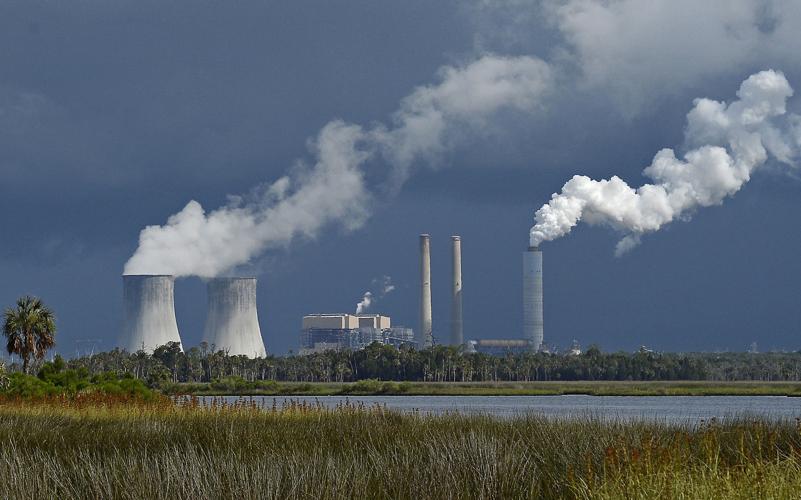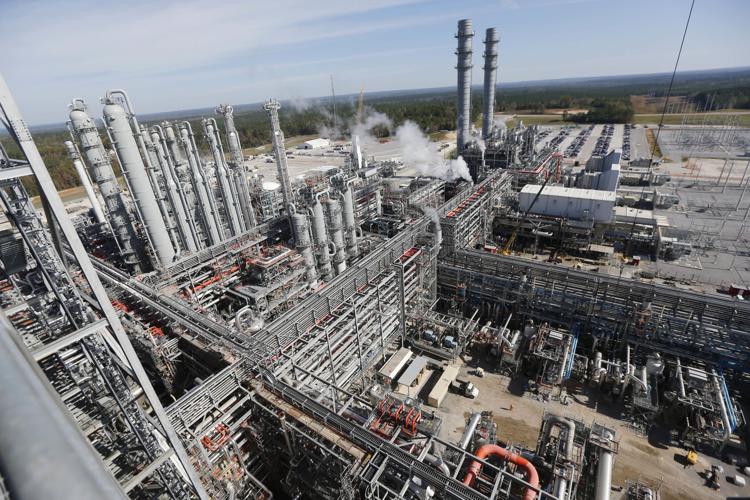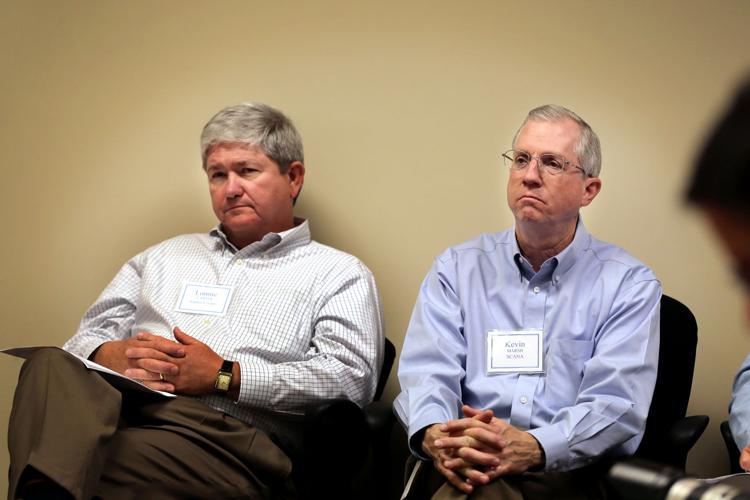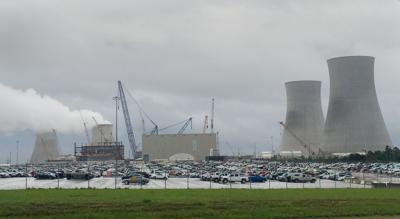Listen to the folks who run some of our biggest electric utilities:
Tom Fanning, chief of Southern Company, in 2016 about its nuclear project in Georgia, which is years behind schedule: “It has gone beautifully. And we’re on schedule.”
Kevin Marsh, CEO of SCANA, in 2016 about South Carolina’s V.C. Summer nuclear project a few months before it collapsed: “We’re excited about where we are.”
Lewis Hay, CEO of Florida Power & Light, in 2011 about nuclear upgrades that cost twice as much as promised: “Our customers should greatly benefit.”
And Fanning again in 2015, this time about his company’s clean coal project in Mississippi, which isn’t burning coal or cleaning it: “We’re on a real winning streak right now.
They should have said "thank you," because money they torched on these and other power plants wasn’t theirs.
It was yours.
Over the past decade, state legislatures across the country rewrote rule books for how power companies pay for new power plants, shifting financial risks away from electric companies to you and everyone else.
This rule change ignited a bonfire of risky spending — $40 billion so far on new power plants and upgrades, a Post and Courier investigation found.
Flush with your cash, utilities tried to build plants with unproven technology; they launched projects with unfinished designs and unrealistic budgets; they misled regulators and the public with schedules that promised bogus completion dates; they hid damning reports from investors and the public; they tried to silence critics and whistleblowers.
Then, when delays and cost overruns couldn’t be ignored, they asked state regulators to charge you more for their failures.
And what happened to these high-stakes gamblers?
Over the past five years, executive teams of six utilities that bet on these plants won $520 million in salaries, bonuses and other personal compensation, the newspaper found.
For this story, a Post and Courier team of reporters interviewed more than 50 industry experts, utility and construction insiders, whistleblowers and others, as well as lawmakers from states that opened the doors to these risk-shifting laws. Reporters pored through tens of thousands of pages of reports, government filings and other documents.
The result is a tale about power — political and electric. It’s about how an industry helped change rules so it could make big bets with your money.
These bets include the now well-documented boondoggle in South Carolina — the V.C. Summer nuclear expansion — $9 billion sunk into two abandoned reactors that may never produce enough juice to run a nightlight.
But they also involve bets on clean coal plants in Mississippi and Indiana.
And nuclear reactors in Georgia.
And projects in Florida and North Carolina that never got off the ground but still cost customers billions of dollars.
These rule changes largely flew under the public’s radar as industry insiders worked elbow-to-elbow with lawmakers to craft laws with obscure acronyms and benign language such as “advanced cost recovery.”
But the results are as plain as the extra money you pay on your power bill, the fewer dollars you have for groceries.
They are as real as the tuition increases at Mississippi universities because of higher power bills.
As painful as the money schools in Georgia forgo for teachers and lesson plans.
The story could begin in many ways. So why not start with a woman in Mississippi who was about to grab her shotgun.

Dragline with view of plant from North American Coal. Kemper County Energy Facility in 2016. Mississippi Power/Provided
‘A coal plant is coming’
Barbara Correro is a feisty woman, small in stature with a rebellious streak. She says “yes, ma’am” instead of “yes, sir” when she agrees with a man. A retired nurse, she lives in Kemper County, Mississippi, which is on the border of Alabama. It's one of the poorest counties in the country with about a third of its 10,000 residents living in poverty. Its population has shrunk by 100 people a year over the past decade — despite all the money that was spent a short drive from Correro’s property.

Barbara Correro lives near the Kemper Energy Facility in Kemper County, Mississippi. Provided
Correro’s home sits hidden in piney woods near cotton fields and rolling hills that also hide deposits of lignite, a form of coal. Longtime residents here talk about how people used to cut off chunks of lignite along river banks to supplement firewood in the winter. It’s sometimes called “brown coal” or “wet coal” because it usually contains large amounts of water. This moisture makes it less efficient to burn in traditional coal plants. Yet, in the mid-2000s, Correro and her neighbors heard a rumor: “A coal plant is coming.”
Those rumors hit home one day when a tanker truck showed up near her driveway. The crew told her they were doing tests for the coal plant. Across from her gate was a pond that she said “was 150 percent on my land.” Without permission, the crew sucked water from her pond into the tanker trucks.
“That’s when I told them they have two hours to get out of there before I shoot that pump.”
They moved. “The tank truck? That was about intimidation,” she said.
More trouble was ahead. A holding company bought thousands of acres around her house. Properties were sold, pitting neighbors who needed money against those who wanted to stay.
She remembers a community meeting not far from her home. An official with Mississippi Power said, "We want you to see the faces of the people you will be working with," according to a story then in the Kemper County Messenger. Other officials told residents they would be fairly compensated for any land that was mined, but they would have to move.
“They were so arrogant,” Correro said. “They were basically telling us that they would close roads, buy land, do what they wanted.”
Behind the scenes, Southern Company and Mississippi politicians had orchestrated a complex but potentially lucrative trade — courtesy of federal taxpayers. Southern Company and a Florida utility had been working on a government-subsidized “clean coal” project near Orlando, one that had fizzled. A Department of Energy memo acknowledged the plant was not “technically or economically feasible” in Florida.
Enter former Southern Company lobbyist Haley Barbour, the avuncular Republican Party stalwart. Elected governor of Mississippi in 2004, Barbour and Southern Company persuaded the Department of Energy to move the foundering project and its $270 million in federal grants from Orlando to Kemper County — and then make it much bigger, more expensive and pin costs mostly on federal taxpayers and Mississippi customers.
The more Barbara Correro learned about the plant, the more she thought it was wrong for Kemper County. In her mind, Southern Company and its subsidiary, Mississippi Power, were gambling with their money and land.
When ground broke in 2010, "I was heartbroken," she said.
Risky as it was, the Kemper County project was part of a much larger gamble — a spending frenzy on new power plants.
The spree’s origins are mostly in the mid-2000s, but it's also helpful to step farther back in time, to the late 1800s and Thomas Edison, who didn’t invent the light bulb.
Monopolies are born
Hard to believe, given the tidy stories about Edison that schools have taught, but historians have long known Edison’s contributions were more nuanced. Other inventors, including Britain’s Joseph Swan, created incandescent bulbs years before Edison filed his patents. Yet Edison did something more important.
He invented longer-lasting bulbs. Then he developed ways to connect groups of bulbs to generators, a grid that could supply electricity to large numbers of customers. In 1882, Edison built the first electric utility on Pearl Street in New York City, igniting a movement to light the world with electricity instead of flames.
A surge of new electricity entrepreneurs in the early 1900s wired one city after another. But many of these young power barons realized that large and duplicative transmission systems were expensive and inefficient. They bought competitors, then urged state governments to regulate their businesses as “natural monopolies.”
It seemed like a fair deal: In exchange for being regulated, utilities solidified their monopoly status and baked in guaranteed rates of return for their investors. Meantime, state public service commissions would make sure utilities charged customers reasonable rates.
But today, the heirs of Edison’s original Pearl Street grid have become a $220 billion industry, one that has shrunk to a patchwork of powerful public and private fiefdoms.
Public service commissioners, some elected, some appointed by lawmakers, are still responsible for balancing needs of consumers and utilities. Yet, when it comes to weapons of influence, consumers increasingly find themselves outgunned.
During the past decade, power companies and their allies spent $1.4 billion on federal lobbying, campaign records show. They gave $112 million to federal candidates. They shoveled millions more into statewide races. They poured money into campaigns of public service commissioners in Georgia, Mississippi and Alabama — states that elect regulators. Relationships got cozy.
In Georgia, electric industry lobbyists ply commissioners with expensive meals and send them smoked hams for Christmas, an Atlanta Journal-Constitution investigation found. Between 2014 and 2016, Georgia Power bought commission staffers and contractors more than 200 meals and refreshments, a review by the Energy and Policy Institute found. Most were small meals, though earlier this year, Georgia Power lobbyists spent $7,700 to feed commissioners and staff at a single dinner at the Lake Oconee Ritz-Carlton. In 2012, a commissioner asked a lobbyist to pave the way for his granddaughter to sing the national anthem at an Atlanta Braves game.
In South Carolina, the state Legislative Audit Council faulted public service commissioners for getting too close with lobbyists and other industry representatives. In response, lawmakers created the Office of Regulatory Staff to defend the “public interest” in cases before the Public Service Commission. But the law defines “public interest” as a balancing act between the needs of customers and “economic development” forces. And this reform push did away with the state’s consumer advocate, who had successfully fought rate increases in the past. Critics said the law tilted the balance against customers at a critical moment.
In the mid-2000s, power companies across the South, including SCANA, NextEra, Duke Energy and Southern Company, had their robust lobbying machines running at full throttle.
An energy gold rush had begun.

Employees work on a section of the Mississippi Power Co. carbon capture plant in DeKalb, Miss., on Nov. 16, 2015. Regulators have reached a settlement with Mississippi Power Co. on how much customers should pay for a troubled $7.5 billion power plant once touted as the future of coal. The unit of Atlanta-based Southern Co. is agreeing to lower the price tag on its Kemper County power plant by $85 million, its second round of concessions in two weeks. Shareholders have already lost $6 billion. File/Rogelio V. Solis/AP
The rule writers
The lobby of the South Carolina Statehouse is a pleasant place to visit. The room’s 19th century treatment is reminiscent of Edison’s time, with stained glass windows, leather couches, mahogany doors and a paint palate of warm browns. When in session, lobbyists and lawmakers huddle around a life-size statue of John C. Calhoun. School groups weave through these conversations on their way to the chambers. John M. Bryan, former professor of art history at the University of South Carolina, once said the lobby’s openness “symbolizes accessibility of government to all people.”
But in the spring of 2007, operatives for South Carolina’s utilities often met behind closed doors, away from the public din of the Statehouse lobby. One meeting took place in a conference room of Haynsworth Sinkler Boyd, a politically influential law firm with an office then next to the Capitol grounds. Belton Zeigler, one of the firm’s lawyers at the time and former general counsel for SCANA, was the host. The subject: A new bill called the Base Load Review Act.
Though he wasn’t a lawmaker, Zeigler had helped draft the bill. Its first words were: "An act to protect South Carolina ratepayers."
It was a dramatic break from the past.
Power companies in South Carolina had raised money for new plants by selling bonds and tapping other financial markets. Then, when the plants came online, they incorporated these borrowing costs in rates.
Put another way, customers paid for new plants when they received something for their money — electricity.
It was like buying groceries: You pay the store and get your food.
But traditional lenders were leery about backing nuclear plants given the financial failures of so many reactor plans in the 1980s.
So power companies came up with another source of money — yours.
And they had just the tool to pry it loose.

Inside the State House in Columbia, South Carolina
Legislative lightning
This tool went by several tongue-twisting acronyms and terms: CWIP, short for “construction work in progress”; AFUDC, short for “allowance for use of funds during construction”; and “advanced cost recovery.”
But they all did the same thing — shift risks of construction projects from power companies to their customers.
Instead of billing you when new plants went online, power companies did it as they licensed, designed and built them.
This tool suddenly made you an investor in a future power plant. It was like paying a grocer as it builds its store — with the hope that groceries might be a little cheaper when it opens.
Water and sewer utilities routinely use cost recovery and CWIP laws for small or predictable upgrades, such as pipelines.
But using these pay-as-you-go tools for nuclear reactors was another matter.
Supporters said new CWIP laws would generate billions of new dollars and help ease rate shock when plants came online. A handful of critics predicted they would encourage big bets on dicey projects.
“There are checks and balances when you pay something out of your pocket,” said Louie Miller, a lobbyist for the Sierra Club in Mississippi. “When it’s other people’s money, it’s easier to take a risk.”
But power companies couldn’t collect any of this new money without help from elected officials.
Which in South Carolina and across the South seemed inevitable.
‘Trust the people in authority’
Like other Southeastern states, North Carolina passed its own law letting utilities charge in advance for big power plants like nuclear reactors.
Bobby Harrell, then-Speaker of the House, said power companies made a persuasive case: They needed more generating plants to keep up with future demand.
“When you’re in the General Assembly, you have a need to be able to trust the people in authority,” Harrell, a Republican, said in a recent interview.
Glenn McConnell, then-Senate President Pro Tempore and another key supporter, warned: "We don't need blackouts like in Baghdad here in South Carolina."
Tommy Moore, a Democrat from Aiken and a champion of the bill in the Senate, said a move toward nuclear energy made sense at the time: Costs of coal plants were rising and natural gas prices were still high. “I don’t remember anyone breathing any caution.”
The spring 2007 meeting with Belton Zeigler, the former South Carolina Electric & Gas lawyer, had been billed as a chance for manufacturers to weigh in. But some attendees left feeling the bill was a done deal.
As industry representatives suggested tweaks, Zeigler cast most of them aside.
"I can remember when we hit a brick wall Belton would say 'I hear you,’ " said Scott Elliott, an attorney for the South Carolina Energy Users Committee, a group that represents industrial customers. “I hear you” really meant the language already was etched in stone, Elliott said. Zeigler declined to comment for this story.
By then, the bill was already filed in the House and Senate, and power companies had done their legwork. They had pumped more than $510,000 into lawmakers' campaigns before the session. More than two-thirds of the lawmakers signed on as sponsors.
Greased by campaign cash, the bill sped through the Legislature at the political equivalent of lightning.
“When you see the title, nothing about it seems controversial,” said Rep. Robert Brown, D-Hollywood, one of the law’s few opponents. “Some people probably went along and voted for it without really knowing what they were voting on.”
The Senate passed it on a voice vote, wiping away fingerprints of those who supported or opposed it.
Chip Campsen, a Republican from the Isle of Palms, was one of the few senators who voiced a no. He’d studied the bill’s language and saw it shifted risks from utility shareholders to customers, which seemed wrong to him.
“There are very few votes over the years that bother you, but this one ... I could not believe we did that.”
Legislators once spent five months arguing about whether to name the right whale or the bottlenose dolphin the state marine mammal. But it took just seven days to move the Base Load Review Act from a Senate subcommittee directly to a final vote on the House Floor. Only 6 of 104 House lawmakers opposed it. It contained no penalties if utilities messed up their projects. Or spending caps.
When the bill went to then-Gov. Mark Sanford for his approval, Sanford declined to sign or veto it, which meant it automatically became law. Tom Davis, Sanford’s chief of staff at the time and now a Republican senator in Beaufort, said it was a “foregone conclusion this was going to be law” no matter what Sanford did.
“This bill was entirely industry driven — in the drafting of it, in the advocacy of it, in terms of putting pressure on legislators,” Davis said. “It was probably the clearest case I could ever see of a special interest using all of its power and leverage to get something passed.”

A worker walks through a section of the Mississippi Power Co. carbon capture plant in DeKalb, Miss., on Nov. 16, 2015. Regulators have reached a settlement with Mississippi Power Co. on how much customers should pay for a troubled $7.5 billion power plant once touted as the future of coal. The unit of Atlanta-based Southern Co. is agreeing to lower the price tag on its Kemper County power plant by $85 million, its second round of concessions in two weeks. Shareholders have already lost $6 billion. File/Rogelio V. Solis/AP
States of influence
At least 11 states passed similar pay-as-you-build laws during the 2000s. Florida utilities lobbied for a nuclear "cost-recovery" bill that left Susan Bucher, a Democrat in the Florida House, wondering: “You’re going to make my senior citizens pay for something they will never see?”
She stood on the House Floor to voice her opposition: “What happens if they don’t complete the plant?”
The Legislature answered with a vote of 158 to 1.
It was a heady time for power companies. In a short period, state elected officials across the country, and especially in the fast-growing South, had created new sources of money they didn’t have before. With an all-you-can-eat buffet of customer cash and taxpayer-funded subsidies, power companies proposed one expensive project after another. Early estimates called for more than $80 billion worth of new power plants and upgrades in the South alone, a Post and Courier analysis showed.
Industry cheerleaders said these plants could transform the South into an electricity powerhouse, one primed to take advantage of future laws that penalized generators for releasing large volumes of carbon dioxide, the primary cause of global warming.
Mississippi lawmakers went all in, passing a law that encouraged both nuclear and "clean coal" plants, including the project in Kemper County — a “home run for Mississippi and the nation,” Gov. Haley Barbour wrote the Secretary of Energy in 2010, shortly before the groundbreaking.
The Kemper County plan was ambitious. Massive diggers would strip mine lignite from the hills and fields around the plant. The lignite would then be converted into synthetic gas. This gas would be burned to spin turbines that generated 582 megawatts of electricity, enough to power 430,000 homes. Two-thirds of the carbon dioxide emissions would then be diverted from the plant’s stacks, captured and sold to oil extraction companies. Southern Company said the plant’s technology could be replicated and sold across the world.
Kemper's potential was one of the reasons Brett Wingo was eager to work on it. His grandfather had been a coal miner in northern Alabama. Wingo did engineering work on the gasification island, the portion that turned lignite into gas.
“I wanted to be part of a solution that saved the industry.”
He never thought he’d end up calling the project a fraud.

Brett Wingo helped design and engineer a "clean coal" plant in Mississippi, but when he tried to blow the whistle on the project's problems, he was sidelined and sued. Brett Wingo/Provided
Construction of a whistleblower
Wingo is a tall man with a low-pitched Alabama twang and a restless energy about him. In a recent interview, his right fist was sore from pounding it during a rare loss by the University of Alabama’s football team. He lives near Birmingham and commuted every week to Kemper County, a two-hour drive. Since he worked on the plant’s original designs, he knew its anatomy like a surgeon.
“It’s like a huge petrochemical plant with giant flares and columns. You had to do the engineering right. There was enough ammonia to kill everyone on the site.”
He won internal awards for his work and was placed in programs to nurture promising managers. He thought the gasification and carbon sequestration technology was sound, but by 2013, he knew the project was in trouble. Already, Mississippi Power had admitted to state regulators that it had hidden $366 million in cost overruns.
Wingo suspected it was way behind schedule, which could add dramatically to its overall costs. Two important deadlines were fast approaching.
The first was May 14, 2014. If the plant wasn’t online then, Southern Company would lose $133 million in federal tax credits — money the company and its shareholders would have to eat instead of customers.
The second was Dec. 31, 2014. Miss that one, and Southern shareholders would swallow another $150 million in federal tax breaks.
Wingo told his superiors that they'd likely never make those deadlines.
But they seemed to ignore his warnings. In public meetings with Wall Street analysts, Southern executives painted pictures of "tremendous progress." They were on track to make those 2014 deadlines — and keep those federal tax breaks.
Then, during the summer of 2013, Wingo was told to build a new plan for the plant’s start-up, a chance to dig deep into the inner workings of the project's overall schedule.
He would soon learn whether his suspicions about the deadlines were right.
'Impossible to make it'
Construction schedules for nuclear, coal, bridge and other major projects are typically done using powerful software programs such as Oracle’s Primavera P6 and Microsoft’s Project.
Much more complex than spreadsheets, these programs allow you to identify hundreds of thousands of tasks: inspections, supply purchases, man-hours, productivity rates and costs. Diligent managers then arrange these variables and many other tasks in logical sequences. For instance, to make reinforced concrete, a schedule might call for installation of rebar, inspections and then the pouring of concrete.
When the data is fully loaded, the program spits out bar charts, cost scenarios — and dates when tasks should be finished. It also gives you a final completion date, along with probabilities this date will be met.
Wingo and his colleagues worked for five weeks to craft their new schedule. They punched in data for more than 5,000 tasks. When they were finished, he sent his findings up the corporate ladder.
“I told them that it was impossible to make that May 1, 2014, deadline, and that it probably wouldn’t be finished well into 2015 or later.”

Tom Fanning, president and CEO of the Southern Company, speaks at an energy summit in Jackson, Miss. in 2012. File/Rogelio V. Solis/AP
But time and again, Fanning and other Southern Company executives reassured Wall Street analysts: Those deadlines were still good.
By early 2014, it was obvious that work at Kemper would continue far past its first deadline and lose the first batch of tax credits. Southern Company executives blamed the delay in part on bad weather. But the second deadline for those tax breaks would be met, Fanning said April 30, 2014. "Well, except for the unknown unknowns," he added. "So what happens if, heaven forbid, there's a tornado that comes across the site? Or what happens if there's a major hurricane? Or what happens if, as we integrate the system, it's just more complex, and we are not able to track it effectively or something?"
Wingo was bewildered by the contrast between the positive public story Southern executives told and the chaos at the work site. He said the company put pressure on engineers to speed up designs, sacrificing safety to meet the deadlines. He worried that workers would get hurt.
In early 2014, he wrote an email to a high-level executive: "I've reached a personal tipping point and feel a duty to act."
Other bets, other losses

Duke Energy's new $3.5 billion coal-gasification plant in Edwardsport, shown on Wednesday, June 12, 2013, started commercial operation on June 7. The 32-story gasification tower is at left. The generating plant in Knox County near Vincennes is the largest of its kind in the world. The new plant produces 10 times as much power as the former plant at Edwardsport with 70 percent fewer environmental emissions. File/Charlie Nye/IndyStar
As Brett Wingo pondered what to do next at Kemper, other pay-as-you-build plans went south.
Like Southern Company, Duke Energy had its own clean coal project. Duke’s was in Edwardsport, Ind., and it earned a reputation for generating scandals as much as electricity. One involved a lawyer for the state’s utility commission: He negotiated a job with Duke as the company sought hundreds of millions of dollars from customers because of construction overruns. The state’s Supreme Court later fined and reprimanded the lawyer.
The Edwardsport project itself was a money pit. Its original price tag was $1.9 billion plus millions more in financing costs. But delays and overruns eventually pushed the tab for customers to at least $3.7 billion so far. In the end, Duke nixed the carbon sequestration component. For their money, customers got a plant that burns synthetic gas, didn’t clean CO2 and cost nearly twice as much to operate as neighboring utility plants.

Duke Energy's Crystal River nuclear power plant in Citrus County, Fla., on June 27, 2013. File/Phil Sandlin/AP
In western Florida, Progress Energy bungled repair and upgrade work on a 30-year-old reactor near Crystal River. When Duke Energy merged with Progress in 2012, Duke decided to shut down the reactor altogether. By then, electric customers had paid $381 million for the upgrade. They will shell out another $1.3 billion for the next two decades to decommission the plant — for no electricity.
Progress Energy also pushed for two new reactors in Levy County north of Tampa, buying land and signing a contract with Westinghouse Electric. But in 2013, after the Duke merger, Florida lawmakers tweaked their cost recovery law. Moving forward, lawmakers wanted utilities to first prove their plants were feasible and made economic sense. This not-so-high bar was enough to kill the project. It created “increased uncertainty in cost recovery,” Duke Energy said then. In other words, Florida lawmakers made it slightly more difficult to charge customers for new reactors.
Duke’s customers still paid about $871 million for land and other contractual obligations — for no electricity.

The Turkey Point nuclear plant is south of Miami. Florida Power and Light spent billions of dollars to expand its existing reactors there and another up the coast. The company has also pushed plants to build a pair of new reactors at the site in a project that would mirror South Carolina's V.C. Summer plant. File/Lynne Sladky/AP
Farther south near Miami, Florida Power & Light is weighing a decision to build two Westinghouse reactors at its existing Turkey Point nuclear station. Though its plans are in limbo, Florida Power & Light charged customers anyway — about $275 million so far. The power company also spent $3.4 billion on upgrades to its other nuclear reactors, nearly twice the original estimates.
Taken together, the Florida pay-as-you-go projects cost customers $6 billion.
Meantime, Southern Company and SCANA burned through billions of customer dollars — more than $9 billion at V.C. Summer in Fairfield County, and $12 billion at Vogtle, south of Augusta.
And as in Kemper County, Mississippi, the Georgia and South Carolina projects had construction schedule issues of their own.

Aerial view of the V.C. Summer construction site in JenkinsvilleProvided/SCE&G
Dishonest schedule
Their contractor, Westinghouse Electric, had touted its AP1000 reactor as an off-the-shelf design. But as construction began, Westinghouse still needed thousands of detailed engineering blueprints and drawings. To get this work done, the company used unlicensed engineers, a potentially criminal shortcut, a Post and Courier investigation revealed earlier this year.
They’d been warned about this practice early on. In 2011, a Westinghouse official circulated a confidential analysis to the company’s leadership. This report predicted the company would lose hundreds of millions of dollars because of its questionable engineering practices and other strategic blunders. But his warnings apparently fell on deaf ears.
"This thing was rotten from the get-go" one engineer from V.C. Summer said. "They were going to do it their way, and they weren't going to listen to anyone."
Questionable engineering wasn’t the only problem at V.C. Summer and Vogtle. Fabrication of the plants’ key components also went badly, especially at a subcontractor’s factory in Louisiana.
Chris Hartz, a quality assurance manager for one of Westinghouse’s subcontractors, said a team inspected the Lake Charles, La., plant in 2010 and found serious problems with welds and paperwork. It was clear that the new facility and its employees weren't prepared to manufacture components that met tighter nuclear safety rules, he said. His team had the power to shut down the site, and it did.
But when he informed a senior executive about the team’s decision, the man threw a letter opener at his head. Hartz said it missed him by a few inches and crashed into a plate glass window.
Chaos at the Louisiana factory added more uncertainty to schedules in South Carolina and Georgia. But you’d hardly know if you listened to SCANA and Southern Company executives.
Stephen Byrne, executive vice president of SCANA, told Wall Street analysts in late 2012 that V.C. Summer’s “construction is progressing well.” Its first reactor was scheduled to go online as planned in March 2017. He added then that SCANA had already sought and won five rate increases under the state’s Base Load Review Act.
“We continue to be pleased that the mechanism is working as designed.”
In reality, both the Vogtle and V.C. Summer projects lacked honest schedules, ones that fully incorporated all the tasks, costs and other variables from beginning to end.
In 2012, a construction expert hired by Georgia regulators sounded an early alarm: The absence of an honest schedule made it difficult for regulators and the public to know when the project would be done and how much it truly would cost.
He issued the same warnings year after year as the overruns grew.
But Georgia regulators approved one rate increase after another.
The same thing happened 120 miles away at the V.C. Summer work site.
In 2015, Bechtel, a consultant SCANA hired to analyze the project, found 50 cases in which Westinghouse's schedule had bogus completion dates. Overall, the schedule didn’t reflect “actual project circumstances,” the Bechtel report said.
In 2016, a construction monitor hired by South Carolina regulators said that Westinghouse managed the mammoth V.C. Summer nuclear expansion on what amounted to three- to six-month “lookahead” schedules.
Behind the scenes, SCANA and Santee Cooper executives wrestled with the project's mounting financial and worksite issues. They kept the Bechtel findings secret from regulators until this year when the governor ordered it released. And they spun a different, much rosier tale in public.

Chairman and Chief Executive Officer SCANA Corporation Kevin Marsh talks to the press at the construction site of the new reactors at the V.C. Summer Nuclear Power Station in Jenkinsville on Wednesday, September 21, 2016. File/Grace Beahm/Staff
In September 2016, Kevin Marsh told reporters: "People ask, ‘If you could do it again, would you make the same decision?’ Absolutely, I would make the same decision. I feel as strongly today — probably even stronger today than I did back in 2008 — that this is the solution for us, for a clean energy future."
And V.C. Summer’s hidden problems didn’t stop SCANA and Santee Cooper from raising rates.
Since 2009, SCE&G has asked for nine rate hikes to pay for its nuclear plant.
Each time, our state Public Service Commission gave them nearly everything they asked for.
Real costs, real pain

An overview of a section of the Mississippi Power Co. carbon capture plant in DeKalb, Miss., on Nov. 16, 2015. Regulators have reached a settlement with Mississippi Power Co. on how much customers should pay for a troubled $7.5 billion power plant once touted as the future of coal. The unit of Atlanta-based Southern Co. is agreeing to lower the price tag on its Kemper County power plant by $85 million, its second round of concessions in two weeks. Shareholders have already lost $6 billion. File/Rogelio V. Solis/AP
For roughly 717,000 SCE&G customers, those rate increases come to 18 cents for every dollar on their monthly bills. It adds up to about $37 million every month, or nearly $500 million a year.
That’s about $40,000 a year in extra utility expenses for the Charleston Animal Society, enough to save 107 dogs and cats, the group says.
It’s about $1.2 million extra for the city of Charleston, enough to pay starting salaries for 26 police officers, city figures show.
It’s about $43,000 a month more on Roper Hospital’s power bill, money the hospital could use to expand its telehealth network and other work, said Bret Johnson, Roper’s chief financial officer.
It’s money for zero electricity.
And that’s just in South Carolina.
As much as $853 million will end up on the backs of Mississippi Power’s 187,500 customers because of the Kemper project.
That's more than $4,500 per customer in a state where 1 in 5 residents have difficulty getting enough food because they're short of money. After a rate increase in 2014, University of Southern Mississippi faced as much as a $1 million jump in its bill and had to raise tuition $236 per student.
Barbara Correro, the early Kemper County foe, said, “I know I’m hurting because of higher electric bills.” And she’s heard that some elderly residents can’t afford to turn on their air conditioners in the summer.
While we forked over money for risky projects that didn't produce power or cost much more than originally advertised, power company executives saw their wallets grow fatter.

NextEra CEO James Robo.
Top executive teams of five Southern utilities collectively earned an average of $104 million a year between 2012 and 2016, or a total of $520 million.
NextEra's CEO, James Robo, earned the most, a cool $16.7 million in 2016. Tom Fanning, Southern Company’s CEO, earned a tad less at about $16 million.
They earned significantly more than SCANA’s CEO, Kevin Marsh, who made $6.1 million that year. Lonnie Carter, CEO of Santee Cooper, which is owned by the state, made the least at $540,000.
Marsh and Carter have since retired amid the V.C. Summer collapse. Other CEOs have survived, including Fanning, though his leadership stock took a hit last week. Analysts for Georgia’s Public Service Commission made a startling recommendation: the Vogtle expansion should be canceled. Given the delays and mismanagement, the project no longer made economic sense for Georgia Power customers, they said.

Former Santee Cooper CEO Lonnie Carter and outgoing SCANA chief Kevin Marsh during a media tour of the now-abandoned V.C. Summer Nuclear Station last September. File/Grace Beahm Alford/Staff
Fanning declined to comment for this story.
But in the fall, he spoke at an energy summit in Chicago hosted by a women’s business group. Participants tweeted some of his comments about leading a large power company.
In one, Fanning was reported to have said: “What you really want as you rise in an organization is the truth.”
Back in Kemper County
So did Brett Wingo.
Suspecting something wrong with the Kemper project’s overall schedule, he analyzed parts that other managers had built. That’s when he discovered that someone had overridden the “logic ties” — sequences of tasks that were supposed to go in order but didn't.
One example: The schedule had the plant’s two gasifiers coming online simultaneously. But he and his colleagues had designed them to fire one after each other, like a rocket booster firing stages. “This had the stages going off at the same time. It was impossible,” he said.
The broken logic ties made progress look better on paper than it was at the work site. Wingo feared the truth of the project’s problems weren’t bubbling up to the executive suites. He worried that Fanning might be unintentionally violating federal securities laws by misleading investors because of a sham schedule. He reported his concerns in an email to an executive at Mississippi Power. But the executive berated him for putting his report in writing because lawyers could dig it up in a lawsuit.
On his way home one day in March 2014 to Birmingham, Wingo decided to call Fanning directly.
He remembers pulling to the side of the road, near a cow pasture. He dialed Fanning's number and was surprised when he picked up on the second ring.
He told Fanning what he’d found in the schedule. He warned him against signing any financial reports to the Securities Exchange Commission that claimed the plant would be done by the end of 2014.
He said Fanning thanked him. “He told me I’d done the right thing.” Wingo drove home, relieved.
But within weeks, project managers excluded him from meetings. They left him off emails. Two colleagues warned he was “digging a hole” for himself. He was ordered to turn over his scheduling duties, a demotion. Wingo began to secretly record calls with co-workers to protect himself.
Wingo eventually filed a job retaliation complaint with the Occupational Safety and Health Administration and another with the SEC alleging the company broke securities laws by misrepresenting the plant's schedule. A Southern Company lawyer allegedly told him his career was over.
At one point, a company lawyer offered Wingo nearly $1 million for his silence, he said. The lawyer "pushed it across the table to me in his offices, gave me 24 hours to sign it and said if I ever disclosed this, he would deny it." Wingo refused the offer. Southern obtained a temporary restraining order to keep him quiet, which was later dropped. "I felt like the company was intent on having their way with me, no matter my protests."
Earlier this year, OSHA sided with Wingo, saying his employer had an "irresponsible disregard to the whistleblower protections enforced by OSHA."
Fanning has described his phone call with Wingo as "a nice conversation," said Schuyler Baehman, a Southern Company spokesman. After the call, Fanning turned the matter over to the company’s general counsel and chief compliance officer. The company investigated Wingo’s concerns and found they were “unsubstantiated and not otherwise supported by the facts,” Baehman said.
Southern fired Wingo in 2016, and he’s filed a federal lawsuit alleging that Southern went after him for trying to tell the truth.
“I never thought I’d be a whistleblower.”
His predictions about the project's schedule came true. Southern missed its deadlines in 2014, and it's still not done. Costs ballooned from $2.4 billion to more than $7.5 billion so far. It won't turn Kemper County’s lignite into gas; that plan was shelved because it didn’t make economic sense. And it doesn’t collect carbon dioxide. That part also was nixed.
One part of the plant does work — the section that burns natural gas.
A new natural gas plant typically costs about $700 million. So at $7.5 billion and counting, industry analysts say Kemper is on its way to becoming the most expensive natural gas plant in the world — smack in the middle of one of the poorest counties in the country.
Lessons learned?
Failure can be a gift when lessons are learned and used to prevent future ones. And the failures of so many pay-as-you go projects across the South offer plenty of teachable moments.
Among them: South Carolina’s V.C. Summer fiasco wasn’t an isolated case. When Brett Wingo sees questions raised about scheduling and overruns at the Vogtle and V.C. Summer nuclear projects, his mind flashes back to what happened at Kemper in Mississippi.
“I’m constantly seeing similarities,” he said.
This industry-wide pattern presents a high-stakes cautionary tale, especially as South Carolina lawmakers talk about possible sales of SCANA and Santee Cooper.
NextEra, Duke and Southern have all been mentioned as suitors. All used pay-as-you-go tools to shift costs of risky projects to customers. And their executive teams took home even more money than executives at SCANA and Santee Cooper.
Meantime, nearly all the laws that launched the gambling spree remain on the books, including South Carolina with its Base Load Review Act and opening proclamation: “An act to protect South Carolina ratepayers ...”






















